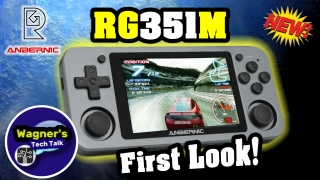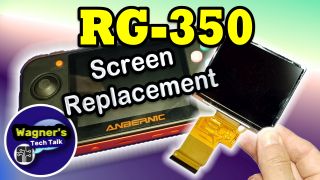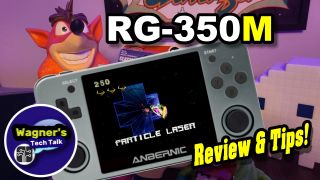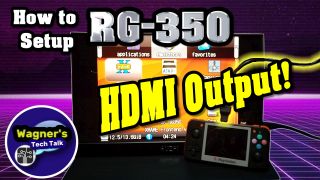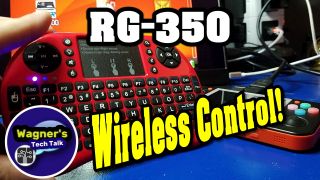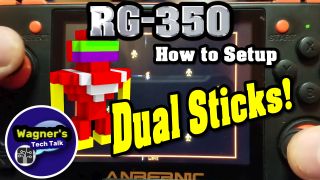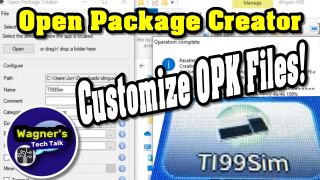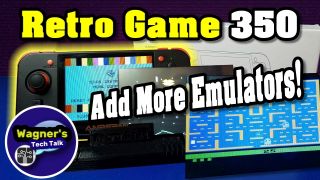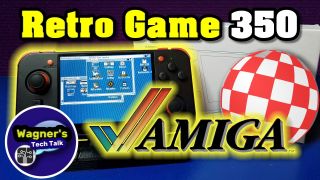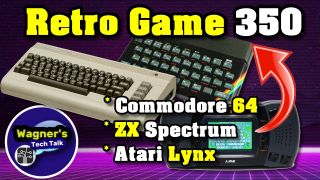RG-350 Guide, Tips, Reviews, Emulators & Resources
Last Update: 8/7/2021
Welcome to the RG350 Tips page! I hope you find exactly what you’re looking for. If you find this content informative, useful or entertaining, please subscribe to Wagner’s TechTalk (YouTube channel).

I realize this page is quite large, there is a lot of information that has been added. While it may not appear at first glance easy to read, it actually can be. If you press Ctrl+F on your keyboard (at least, in Windows) you’ll see a search bar appear. Type in a single keyword such as “HDMI”. It will take you to a relevant section, such as the HDMI update (keep searching next/ENTER until you find what you want). Many sections will have a video to help explain things better, either from me or another content creator that has already covered the subject. Also, checking the table of contents can help find larger subject areas as it relates to the RG-350/M. If you find that what you are looking for isn’t found here, let me know in a video comment and I’ll try to help. The goal is to make it easier to find everything related to the Anbernic devices. These tips for the RG350 tips page should help 🙂
Most everything is on this one page to make it easy for you to Print-to-PDF and save it to your computer/mobile device. If you have your own tips/tricks not found below, please comment in any of the videos (I do read and respond frequently). Also, please let me know what you want to see in the future. I do my best to accommodate.
All content on this page is for educational purposes only. I want to extend a HUGE Thank You to the developer community that continues to improve this AWESOME platform and handheld! Of course, a huge thank you to YOU for reading this far! You are going to love the RG-350/RG-350M and I hope that I can make it a little more fun for you!
Jon
And so, the Journey begins…
I purchased the Retro Game 350 (or RG-350), it took about 20 days to ship from China. They are also available on Amazon here, so you won’t have to wait nearly as long. Within 4 days of it’s arrival, mine arrived 11/14/2019, I spent a lot of time with the unit and created my initial review (first video below). While making this video, I was thinking ahead of the next steps and realized there was much more I wanted to learn and talk about.
While learning new things, I decided to make the process public on this page. It has grown into something a bit more than I originally planned. If you have any recommendations, find errors or tips of your own, please let me know. Any assistance to make this page more informative is greatly appreciated.
Also, please share this page with anyone that might find it helpful. Let’s get started!
Linking to this page: of course, including my friends and fellow YouTubers! You’re more than welcome to link to any of the information you find on this page. I will not be changing any of the headings above the very bottom heading that states Adding Emulators Placeholder and should remain valid.
How-To link to a specific heading on this page: go to the Table of Contents and click a section to reference from there. Copy the URL in the address-bar and paste in your video description/post/blog. This will direct a user to a specific section below, very easily.
Table of Contents
Where to get an RG350?
There are a number places you can find an RG350, below are just a few. May add more later :
- RG350 on Amazon (where I normally buy, availability varies)
- RG350 on Amazon (another Link)
- RetroGame300.com (where I bought mine) – Ships from China, may get it cheaper but will take 20, or so, days to arrive -if in the USA
- AliExpress (ships from China)
- RetroMiMi (ships from China)
Interested in an RG-350M? TomTop has sent me an RG350M for review, you can watch that video here (thanks TomTop!)
- RG350M Game Console – This is the latest incarnation of the RG-350 model line. The “M” designation, from what I understand, is that it utilizes machined aluminum alloy (via CNC machines). There are various colors including: Gold and Gray among numerous enhanced features. I have received this unit and you can find my current write-up and video here.
Interested in a smaller RG280M instead? Check out my review here.
Retro Game 350 (RG350): Unboxing, Gameplay +Review/Tips – Demo of PS1, MAME(ARCADE), NES, SNES & FBA
This was my first RG350 video before I really started tinkering with additional emulators, firmware upgrades, etc.
Start here to get a good feel of the RG350. See below for more videos, mini-tutorials, helpful resources and content that have been added.
My review didn’t stop with this video!
Helpful Resources
The following are some helpful resources I’ve run across along with a brief note / description about why it might be helpful to you. If you’re aware of others, please let me know.
- OpenDingux Application Repo (Repository) – Looking for the latest downloads for emulators, applications, firmware updates, frontends and more for your RG-350? This is the site to visit!
- dingoonity.org – Thanks to a WTT viewer that let me know that many of the GCW Zero emulators (see the Releases thread under GCW Zero) will run on the RG350 without the need to build/compile.
- Retro Game Corps – Excellent site for information on the RG350, 351p and several others. Russ makes some great tutorials and videos, definitely go check it out.
- Jutley’s Website – Firmware upgrade, forums and additional information.
- Anbernic – Link to the company which created the RG-350, RG-350M and RG-280M.
- OpenDingux Software List – List of available emulators, consoles, applications, etc.
- Firmware Update Guide – Our RG350 firmware upgrade guide and experiences.
- RG350 SubReddit – Great information source for the RG350.
- RG350 Downloads – Link to browse the latest firmware (see above link for official release), skins, localpacks and more.
- RG-350 Discord – great place to meet/speak with other RG350 users and technical folks.
- GCW Zero Wiki (old archive) – Many of the programs that run on the GCW Zero will work, without modification on the RG350.
- Eduardophile Notes (in Spanish but translates well to English) – Excellent collection of notes, tutorials and links on the RG-350 and related emulators.
Facebook Groups
Below are a list of Facebook groups that discuss the RG-350 or Retro Gaming devices.
Helpful Accessories
Below are the accessories I’m experimenting with. The magnetic USB-C adapter is indeed charging and makes it very convenient. The OTG cable works and adapts any USB device from USB-C to a standard female USB-A input. The keyboard is working via the OTG cable. I can navigate using the arrow keys and the track-pad works in the Stella (Atari 2600) & UAE4All(Amiga) emulators. More to figure out on the computer emulation side (TI-99, UAE4All, Amstrad, C64, etc.), but locating any documentation on .kbd files is difficult. Hoping to use the RG350 as a full portable Retro Computer but this may/may not be possible yet. More details below on what I’m currently using.
- Magnetic Charger AND Data Transfer – Not only does it charge your RG-350, but also allows data transfer (3.3ft cable). This is great in that now you can leave this bad boy plugged into the right USB-C port and reduce wear and tear on your beloved device! It also includes two other adapters: microUSB (many Android +others) and a Lightning adapter (for apple devices). Just pick it up and go!
- USB C to USB (Type A) OTG Cable – This is needed to convert the USB-C on the RG350 to USB type A which is used by most all current accessories (keyboards, mouse, etc.). I have had limited success using the OTG cable to connect an external USB Controller. That is, it worked only with the Atari 2600 emulator (stella) and only using the stock (non-upgraded) firmware. It required mapping the buttons to the Left/Right/Up/Down/Fire buttons. I could use either the external USB controller or the RG350 controller, but again only with Stella.
- Rii 2.4GHz Mini Wireless Keyboard with Touchpad – While I love the fold-able Bluetooth keyboard (below), the Rii keyboard will have to win in overall usefulness. With the wireless dongle connected, it is possible to play many games away from the unit itself. This is great in the case where you’re using the HDMI Output update.
- The Hagibis Bluetooth 5.0 Transmitter Receiver is pretty slick. It can be used with any Bluetooth headphones or receiver you own. It can be re-charged using a micro USB cable and works with many different devices, all it needs is a 3.5mm audio jack (like the one on your RG-350(M)! It was a little tricky getting it paired. I first put my receiver (headphones/speaker) in pairing mode. Then held both buttons on the transmitter until it started blinking. Then pressed the bottom button one tap at a time until the receiving device made a noise. At that point, it was paired and remembers the paired device. I tested it with a standalone speaker (above) and Bluetooth headphones. Both work great!
- Foldable Bluetooth (or USB) rechargable portable keyboard – (NOTE: I recommend the keyboard above over this one). This keyboard is working -sort of. Keyboard mappings for the Retro Consoles (TI-99, Amstrad, etc.) partially work but the keys respond well. Also, the trackpad/arrow keys respond in the Stella emulator! Attempting to use this keyboard within a classic console such as the TI-99, Amstrad does not do very much. It appears a .kbd file is needed, but I’ve yet to figure this out and have found no documentation.
- RG350 Protective Storage Case (Accessory)- I received this accessory and it fits the RG350 nicely. The top and bottom is reasonably sturdy, but the sides are not as strong. It’s a good case for transporting your RG350 but may not hold up to serious pressure or excessive weight. You can see this in a recent video (towards the end) here. This item ships from China, so for those of us in the US it will take nearly a month to arrive.
- Anbernic RG350 abxy button generator / replacement buttons (Thingiverse – 3D Printed) – Looking to 3D print some replacement buttons, check this out! *Note: I have not personally tried this -yet.
- Anbernic RG350 stick generator (Thingiverse – 3D Printed) – Need to re-print a new stick for the RG350, check this out! *Note: I have not personally tried this -yet.
- Anbernic RG350 DPAD generator (Thingiverse – 3D Printed) – Here’s a tool to create a new D-Pad for the RG350. *Note: I have not personally tried this -yet.
FREE Handheld Retro Gaming Stand (3D Print) – fits the RG350 (and others) check it out here. This is the same stand used in many of my RG350 videos and a great way to display your cool new device. It was designed by me and is free for you. Enjoy!
Specifications
The following are the specifications for the RG-350.
- Screen – 3.5 Inch IPS screen 320 x 240
- CPU – JZ4770 1.0 GHz MIPS
- RAM – 512M DDR2
- Internal SD card – 16GB – must unscrew back cover to access (x4 screws).
- External SD card – Support up to 128GB (my original box stated 64GB maximum, though 128GB seems to work just fine).
- Battery – Li-polymer 2500mAh battery which provides roughly 5.5-6 hours of continuous use.
- Charging Port – USB-C (USB2 port on the right).
- OTG Port – USB-C (USB1 port on the left) can be used to connect an external controller, keyboard, etc. to the RG-350.
- OS – OpenDingux
Issues List
The following are a list of issues I hope to figure out a solution for, either via firmware, emulator update or other means. If you know how to solve any of these, please comment on one of the videos and let me know (I’ll update this page accordingly):
Mame4All does not recognize the right joystick(great for games like Robotron, etc). [ Solution: See this ]- PS Emulation does not recognize the left joystick.
- No sound on the TI-99 Emulator (needs an update)
- Figure out how to rotate the Mame4all display left-to right (instead of right to left), ideal for vertical games (i.e. Galaga, Ms. Pac-Man, etc.)
Figure out a way to utilize the A/V or HDMI Output to a TV/Monitor, this currently does not work using the stock firmware. [ Unlikely we’ll see this anytime soon ]– I WAS WRONG, See this instead!
Interesting Tips
In the video below we’ll cover 10 important TIPs that will make using your RG-350 even more enjoyable. It includes how to convert & play videos on the RG350, playing 2-player games using the Stella (Atari 2600) emulator and several more.
- Should I upgrade the Firmware? – In my humble opinion, I would wait. Many have been happy with Rogue, but if you want to use your RG-350 with the latest HDMI update you will need the core 1.5.1 firmware. You can read many of my reasons for not recommending a firmware upgrade here. If you do decide to give it a go, please DO NOT overwrite the microSD that came with your unit! If you do and problems arise, you won’t be able to go back. If you want to make a backup of your current firmware, please see this.
- My RG-350 isn’t charging, why? A USB 5 Volt / 2.1Amp charger should be sufficient, use the Type-C connector on the right (USB 2). If you use a switching supply or a fast-charging solution it may not charge or cause problems.
- I Upgraded the Firmware, now there is nothing under the Games tab – Some of the firmware upgrade guides and YouTube videos do not inform you that you may lose what was originally on your device (primarily, the freeware games that were installed). There are ways to bring them back, but some are quite cumbersome. It is recommended, at the present time, that if you do upgrade your firmware make sure to do so on a clean microSD and keep your original safe!
- I want to upgrade my firmware, how do I Backup/Restore my game saves? Please see this.
- How do I set the Emulator Directory? Launch the emulator, then to go to the root directory (press ‘A’ on the “.” or “..” until you see a sub-folder called ‘media’), then select /media/sdcard ( or /media/[SD Card Name] ). Next, browse to the appropriate sub folder that contains the games/roms for the emulator you just launched. Then press the Start button to set the directory or select the game and press the ‘A’ button. In most cases, the emulator will remember this starting folder location. There are a few exceptions, mostly consoles such as the Commodore 64 (Vice) emulator, among others.
- Is there any easy way to add .opk files without having to copy to the internal microSD? Yes, if you create a sub-folder on your (external) microSD card called “/apps” you can install/copy any additional .opk files in the “/apps” sub-folder and they should then show up on the RG350 when you re-insert the microSD card or navigate to the emulators, games, etc. tab.
- Is there an easy way to access the emulator menu? In fact, there is thanks to Rob B. for the tip here. This doesn’t work in all the emulators, but it does work for several that I’ve tried. While in the emulator, press the power button once and it functions as a menu button. From there, you can access other functions supplied by the emulator.
- My MAME4ALL button configuration is hosed, can I fix it? Sure, the following will delete the configuration for mame4all. Go to the applications tab and select DinguxCmdr. On the left-side, navigate to the root by pressing the ‘B’ button until you see a sub folder called media. Select the media folder (press ‘A’), select home (press ‘A’), select the .mame4all folder (press ‘X’), move down to Delete and press ‘A’. Then exit DinguxCmdr (press ‘Y’) move down to Quit (press ‘A’) and launch mame4all emulator. Press the “..” until you’re at the root and select /media/sdcard/roms/mame4all (or wherever you have your roms installed), then press the Start button. You should now see a list of mame roms, select one and press the ‘A’ button.
- In MAME4ALL playing Marble Madness there appear to be some scaling artifacts/horizontal lines as the screen is being scrolled, can it be fixed? Yes, set the Video Aspect to “Normal”, Video Sync to “Dbl Buf”, Frame-skip to “Auto”, then launch the game. You’ll find those artifacts disappear.
- In some of the older games in MAME4All, there are missing sounds. How can I fix this? For some of the older systems, it was easier to provide pre-recorded sounds rather than emulating the sound chips. For some games like Donkey Kong, Berzerk, Galaga, Gorf, etc. you will want to create a sub-folder under your MAME folder called samples. Within that folder, you’ll copy all the samples as .zip files (i.e. gorf.zip, dkong.zip). In my case, the sub folder structure is /media/sdcard/ROMS/MAME/samples (but yours may be setup different). The next time you start MAME those samples will be used and the audio will be as you remember them.
- My USB-C to USB-C cable is not working, why? – You can’t use a USB-C to USB-C cable to charge your RG350. You must use an USB-A to USB-C cable, like the one included with your RG350.
- What kind of battery life can I expect with the RG350? Here is an excellent video (by YouTube creator Llcooljdj) which compares several handheld devices, including the RG350. In these tests, the RG350 lasted 5h 49m, that’s pretty impressive.
- Games don’t show up on the RG350 – If you are unable to see your games when inserting an external microSD, make sure the microSD card is formatted as fat32 (in windows). Formats ext2/ext3 are fine as well for other platforms. Obviously, backup any files on the microSD card before reformatting. This is a very common problem that I see in the video comments.
- How should I organize folders on my external microSD? It is best to organize the games (ROMs) on your external microSD according to the type of games contained within it. For example, create a folder called /ROMS and subfolders for : C64, CPS1, CPS2, FBA, GB, GBA, GBC, INTELLIVISION, MAME, NES, SNES, etc. and place the games under each. (Please don’t ask where to get Roms, I can’t answer any questions)
- PSX File Extensions – The Playstation games I’ve tried that work have file extensions .ccd, .img and .sub or .bin, .cue or .nfo. For more info, see this.
- What is the difference between USB1 & USB2? USB1 (Left) is used to connect an OTG Adapter (USBC-C to Female USB-A) to allow you to add additional peripherals such as a an external USB Controller, Keyboard, USB-C to USB-A (multiple port) Hub, etc. Some that I’m experimenting with can be seen above. The USB2 (right) is used for data transfer and charging your unit with the USB cable that was included with the device (USB-A to USB-C).
- How can I tell what Firmware Version I’m using? There really isn’t a perfect way, at present. The RG350 can tell you the build (compile) date, but that’s about it (this may change in future builds). At this point, this is a best-guess as to which firmware you’re running: 2019.10.10 (v1.4), 2019.10.18 (v1.5.0) & 2019.10.27 (v1.5.1). If none of the above dates are a match, I don’t know the answer.
- Emulator File Formats – You may be wondering, should my roms be zipped or unzipped? That’s a good question and here is a basic guideline that might help: If the rom is used by Mame4all, keep it zipped. For some others, some will work off of .zip files others won’t. If unsure or having trouble, try unzipping one of the archives and see if it works.
- How do I adjust the brightness of the screen? Press and hold the Power button + Volume +/-. See Hotkeys section for more.
- How can I use the Joystick in PSX4All? – Launch a game, the press the power button. Then select Core Settings and set Analog Mode to DualShock. Then press the ‘B’ button twice to back out of the menu. The sticks should now work.
Exiting the Various Emulators
Many emulators have different methods of exiting. It’s easy to forget and can be frustrating for a new RG350 user. The table below will help you learn how to exit each emulator. I also recently added a column to indicate if it’s OK to leave files zipped or not. Please comment in a video and let me know if you find .zip files work for any of those below I don’t specifically indicate (I just went by what I tried for this initial list).
*NOTE – You may be able to access the emulator menu by pressing the power button once. While in the emulator, press the power button once and it functions as a menu button. From there, you can access other functions supplied by the emulator. This doesn’t work in all the emulators, but it does work for several that I’ve tried.
| Emulator | Exit In-Game | Exit List | Uses .zip ROMs? |
| FBA (Final Burn Alpha) |
SELECT + START + L + R Then, move down to ‘Exit’ and press ‘A’ |
Press SELECT twice |
Yes |
| Fceux (NES/Famicom Emulator) |
SELECT + START Then, move down to ‘Exit’ and press ‘A’ |
Press START | .nes |
| Gambatte (Gameboy Emulator) |
Press R (top-right bumper) Move down to ‘Quit’ and press ‘A’ |
Press START | Yes |
| Genesis Plus GX (Genesis Plus GX for GCW-Zero) |
SELECT + START Then, move down to ‘Quit’ and press ‘A’ |
Press START | .md |
| Oswan | Press SELECT Then, move down to ‘Exit’ and press ‘A’ |
Press START | ? |
| Pcsx4all (PS1 Emulator) |
SELECT + START Then, move down to ‘Quit’ and press ‘A’ —————— On the NEW Firmware, press the POWER button to bring up the menu |
Press START | Many Types OK |
| Picodrive (Megadrive/Genesis Emulator) |
Press SELECT Then, move down to ‘Exit’ and press ‘A’ |
Press START | .bin |
| PocketSNES (Super Nintendo Emulator) |
SELECT + START Then, move down to ‘Exit PocketSNES’ and press ‘A’ |
Press START | Yes |
| ReGBA (Game Boy Advance Emulator) |
SELECT + START Then, move down to ‘Exit’ and press ‘A’ |
Press START | .gba |
| mame4all (MAME Arcade Emulator) |
L + R + START (I recommend re-mapping exit to L + R) |
L + R | Yes |
| gngeo (NEOGEO Emulator) |
SELECT + START Then, move down to ‘Exit’ and press ‘A’ |
SELECT (1-2 times) |
Yes |
Hotkeys
Contents below taken from the RG-350 wiki located here.
| Function | Shortcut |
| Sharpness adjustment | power + Up / Down |
| Force joystick mode | power + B |
| Brightness adjustment | power + volume Up/Down |
| Change hardware scaling | power + A |
| Take screenshot | power + X |
| Force return to gmenu2x/reload gmenu2x |
power + Select |
| Reset | power + Start ( or reset button) |
Replacement Parts
Sometimes parts wear out or break and may need replacing. Below are links that I’ve come across that might be helpful to you. You’ll also find below a video which discusses how to replace the stock RG-350 display with a new one.
- Retro Game Case – This site has some replacement parts for the RG350/RG350M in case you need them (ships from Singapore).
- RG350M 640 x 480 3.5″ IPS Screen Replacement
- Replacement Screen for RG350 – Seller is on ebay, took forever to receive (3-4 months) but it did arrive –eventually. If you’re in a hurry, don’t buy from here.
- MyRetroGameCase – RG350/GKD350H 320×240 3.5 in IPS display. Seller on Etsy, never ordered from here.
Will a 256GB or 512GB microSD work?
I’ve been asked if the RG-350 or the Pocket Go version 2 support larger capacity microSD cards. My honest answer up to this point was, I’m not sure. Well, in this video we’ll bring them to the test to see if a 256GB or a massive 512GB will work for your games on both. In all these tests, we used the existing (base) firmware that shipped with each unit and used the secondary (or storage) microSD only for these tests. ** Spoiler ** Yes, they do!
Links to the microSD cards used in this video
- Samsung 256GB 100MB/s (U3) MicroSDXC EVO Select
- Samsung 512GB 100MB/s (U3) MicroSDXC Evo Select
- Samsung 128GB 100MB/s (U3) MicroSDXC EVO Select
*NOTE – Use caution with the following tool, always tipple-check that the drive you’re formatting is indeed the one you want formatted. Once formatted, it will ERASE all data on the selected drive. That said, this is the download link to the free tool used in this video: FAT32 Formatting tool (for Windows and they do accept donations).
DinguxCmdr Mini-Tutorial

The following tutorial will help you become more comfortable using the included DinguxCmdr tool.
DinguxCmdr is a utility that may be found in your applications tab (press the top L/R buttons to select the applications tab). It is very similar to using the file explorer in Windows. If you plan on adding additional emulators to your device, it’s a good idea to become familiar with this utility. It will allow you to move/copy files from one location to another as well as rename or delete files/folders, create new sub-directories and more.
Your device has two microSD slots, one used for the firmware (I refer to this one as the internal microSD) and the other meant for storage (referred to here as the external microSD). While some may prefer to use only the firmware microSD others may prefer to utilize the secondary (or external) microSD for games, emulators or applications they have added to their device. The advantage of keeping all installed applications on the external microSD is that if you upgrade your firmware (or move to a new Dingux-based device), those applications will appear on the new/updated device.
This may be done by copying all .opk files into a folder on the external microSD in a subfolder called apps (or /apps without the slash and off the root of the microSD). However, if you add new emulators to your system, you may also need to copy BIOS files (the software needed by the emulated machine) to the internal microSD. It is for that reason, understanding how to use DinguxCmdr, will be useful. I typically copy all BIOS files to my external microSD to have them easily available when swapping between devices or testing a new firmware revision. When needed, I simply copy them from the external microSD to the associated sub-folder on the internal microSD.
When DinguxCmdr first starts up, you’ll see two panels. The left and the right. You can alternate the file management by pressing either the Left/Right d-pad buttons to alternate between each panel. You can navigate either side independently, therefore it doesn’t matter which side is the internal/external microSD or within either of the two. That is, you can copy/move/delete files from either side regardless if it’s internal-internal, internal-external or external-external (Again, I typically refer to internal being the firmware microSD and external as the storage/game microSD).
However, if you will be copying/moving files, you’ll need to determine which side is the source folder and which one is the destination folder. If you want to copy a file (or files) from one folder to another directory you’ll want to first set the destination directory, then switch over to the opposite side (d-pad left/right) and select the file/folder (or files) to be copied/moved. The selection can be one of the following:
- Select one file – simply use the d-pad up/down to highlight the file/folder.
- Select All – Press the ‘Y’ button, then Select All on the source location and then press the ‘A’ button to select all files/folders in the selected source location.
- Select None – Press the ‘Y’ button, move down to Select None and press the ‘A’ button which de-selects all files/folders previously selected.
If you wish to copy multiple, yet selective files/folders from a source location to a destination, you’ll need to do that on a one-by-one basis. It is in this case where it may be easier to remove the microSD and install it into your computer and manage files that way. Alternatively, you can use an FTP client such as WinSCP, FileZilla or Windows Explorer itself using this method.
Two key buttons you’ll need to understand early-on are the following:
- ‘A’ button will perform whatever action you have selected (use caution here, especially when using move/delete/rename).
- ‘B’ button will go back from any selected action.
I like to think of the ‘X’ button as your primary Action button. That is, if you press ‘X’, you’ll be prompted to perform one of the following functions (press the d-pad up/down to highlight the option):
- Copy – This will copy the selected file(s)/folder(s) from your source location to the destination (folder).
- Move – This will Move (copy, then delete) the selected file(s)/folder(s) from your source location to the destination (folder).
- Rename – This will allow you to rename the selected file/folder.
- Delete – This will completely remove the selected file(s)/folder(s).
Remember, to confirm any of the above actions you would press the ‘A’ button. If you want to back out, press the ‘B’ button.
To Quit DinguxCmdr, you simply press the ‘Y‘ button and move down to the Quit option and press ‘A’.
I hope the above walk-through has been helpful in making better use of the DinguxCmdr application. It’s a pretty handy tool to master. Just use caution when moving/renaming/deleting files from the internal firmware microSD as those operations could cause problems. If you have a good understanding of file/folder management from your Windows/Mac/Linux machine, you should be in pretty good shape here too.
RG-350M and the Classic RG-350
The latest model of the RG-350 is the RG-350M. The RG-350M, based on my understanding, is notated with an “M” designation due to the fact that the chassis is machined aluminum, but there are several more differences noted below. There are different color variations for the RG350M, as there are with the RG350. These include: Space Gray, Space Silver and Rose Gold. I received the Space Gray from TomTop for purposes of review. The information you find in this section is exclusive to the RG350M and include my notes and honest observations of the unit.
- RG350M Game Console – TomTop was kind enough to send this unit for review. If you’re considering purchasing an RG350M, the price here is $110 and may be cheaper than other sources for the original RG-350. If you are considering buying your first RG-350, I would recommend the RG-350M. See the video above or the section below for more reasons why.
Differences
There are some differences between the RG-350M and what I consider the “classic” RG-350 (plastic or non-metal version). These are:
- RG350M utilizes a machined aluminum frame. As such, it appears more durable and definitely has a more rugged weight to it.
- The location of the sticks have changed, instead of having the left stick above the d-pad, it has been positioned in the lower-left (and d-pad above it). Many people prefer this orientation and was a deal-breaker on the classic RG-350. Personally, I’m fine with either orientation.
- The power button on the RG350M has been moved to the top right-side of the device rather than the bottom. I prefer this new orientation as for many emulators, a quick press of the power button results in a menu option appearing for the emulator. It was a bit awkward doing this on the classic RG-350.
- The reset button has been moved to the bottom-center of the unit and is a bit more recessed than the classic RG-350.
- The sticks on the RG-350M are lower-profile and far more “pocketable” than the sticks on the classic RG-350. Yet, they still feel and work great. For the classic RG-350, you can relatively easily replace those sticks with those available from Sakura Retro Modding. The sticks on the RG-350M are fine as-is, in my opinion.
- Similarly, the volume buttons have been moved from the bottom side of the classic RG-350 to the upper-left side of the RG-350M. A subtle, but improved orientation.
- The RG-350M now has a 640x480p display where the classic RG-350 has a 320x240p display. The display on both look great, however the higher resolution on the RG-350M is obvious (see image below as an example). In the main screen of the RG-350 you can clearly see some pixelation which is not nearly as evident on the RG-350M. The new screen has some obvious improvements. The only negative aspect is that the battery between the two devices remains unchanged, therefore you may get slightly less playtime on the RG-350M vs. the classic RG-350 (though, the specifications of both state about ~6 hours).
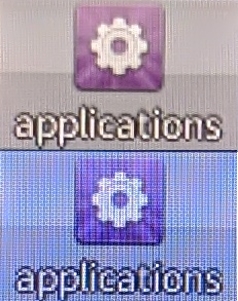
*Note: close-up of the applications icon were shot from one single image and enlarged for better viewing (no other alterations).
- On the classic RG-350, you would have to remove 4 screws on the back to get access to the internal firmware microSD (see here for creating a firmware backup). On the RG-350M, the internal microSD has been moved to the lower-left with a Q/C sticker over it. This will allow you to easily update future firmware versions without opening the unit. This is a huge plus, in my opinion.
- The RG-350M that I received did not include the HDMI Output patch pre-installed (more here). However, I’ve had two individuals who have received their RG-350M recently that does already include the HDMI Output patch. My assumption is that all future versions will have this built-in.
Aside from what has been identified above, there are no changes to the CPU, RAM or any of the internals. Therefore, emulation performance won’t be any different than that seen on the classic RG-350.
Emulation
I have found no major differences in emulation between the RG-350M and the classic RG-350. All the emulators I’ve tried, so far, all appear to work equally well on the RG-350M as they did on the classic RG-350. One of the first emulators I tried was Daphne (Space Ace / Dragon’s Lair) as I had thought this might show some issues. But no, it plays beautifully!
While I prefer to stick with the stock firmware, aside from the HDMI patch which allows HDMI-out support, there has been a new release of the Rogue CFW (Custom Firmware). I know many will be happy to learn about this. You can find a post about it here. I may cover this release in a future video, if there is interest. If so, please comment in one of the RG-350 videos and let me know you would like to see it reviewed.
Replace Firmware microSD with a Larger One
If you want to replace your existing 16GB firmware microSD card with a larger capacity microSD card, these instructions should help. I recommend keeping your original firmware microSD safe and never re-write the original microSD. Here are a few reasons why you may want to do upgrade it:
- Your RG-350M doesn’t already have the HDMI Output support but you want to add it. For this reason, it’s a good idea to have a backup copy of your original firmware and apply the update to a new microSD.
- You want to be able to add more roms/emulators, etc. to the internal microSD than will currently fit on it. Keep in mind, for most, simply copying the emulators to an “apps” sub folder on the right-side microSD (TF2/EXT) should be sufficient for adding emulators. Though, for others they may want to fill up both microSD cards for varying reasons.
Backup / Restore Steps
- First, remove the firmware microSD on your RG-350M (the left microSD card). You’ll have to remove the QC sticker and this WILL void your warranty!
- Place the microSD into a reader/sleeve and follow this procedure (steps 5-12). *NOTE: Ignore the first 4 steps regarding removing the screws, this is unnecessary for the RG-350M! Keep your original RG-350M firmware microSD SAFE, once backed up.
- Once the backup image has been created, insert the NEW firmware microSD card you wish to use into your computer and follow these instructions to burn your original image to the new microSD card (I used a Samsung 128GB microSD). You should be able to use any brand/size you prefer. You should also save off your original firmware .img file to a NAS or other safe location for future use, should you need to.
Expand Partition
After you restore the microSD card to a larger capactiy card, there will be unused space if the destination microSD was larger than 16GB. This space will need to be reclaimed in order to get any benefit from the additional storage. There are a number of ways you could expand the partition on the microSD card. I’ll detail one below and reference two additional methods. If you attempt to expand the microSD by not using one of the methods mentioned here, you’ll likely just see a black screen after you restore the image to the new card. To resolve that, here are a few different methods – pick the one you’re most comfortable with:
- Use a Raspberry Pi with gparted (detailed below)
- See this video: RG350M Howto – Upgrade to a 32GB Internal Boot SDcard by Kurt Frary. Kurt demonstrates another method that won’t require a Raspberry Pi and can be done using Disk Genius in Windows. I’ve personally not tried it this way.
- Another option, might be using a Linux live USB distribution. I’ve personally not tried it, however it was mentioned on the RG-350 subreddit (credit to PirandelloKruger723) to use Linux live USB, and therefore no Pi would be required. This also seems like a good approach, if you don’t already have a Pi available. He goes on to mention you can get gparted in the Debian repos.
This section is a bit more technical than many of the procedures on this page and you will need a Raspberry Pi to follow along (3/3b+ or 4 Model B). In my case, I used a Raspberry Pi 4 Model B (you could use a Pi 4 with 2/4 or 8GB – I used 8GB). This procedure won’t cover how to install Pi OS (formerly known as Raspian), for that please see this page.
- Insert the NEW firmware microSD card into a USB reader, boot up your Raspberry Pi running Pi OS and insert the USB reader into one of the available ports on the Pi.
- Open a terminal window and run the command to install gparted:
sudo apt-get install -y gparted
- Next, start gparted by typing:
sudo gparted
- In the upper-right, you’ll see a drop-down that may say something like /dev/sda (size GiB). Select the microSD you recently flashed. It should resemble the following image:

- We will extend the ext4 partition on the microSD to fill the un-allocated space (104.84 GiB in this case – I used a 128GB microSD card).
- Select the ext4 partition, right-click and select Resize/Move.
- Drag the right-side of the slider to the far-right (allocates the full-size of the microSD). See image below:

- Now, click the Resize/Move button to resize the partition.
- Click the green Apply All Operations icon on the toolbar to apply the resize operation.
- When asked if you’re sure you want to apply the pending operations, click the Apply button (after double-checking, of course). You’ll then see the microSD being resized as shown here:

- Once resized, you can shutdown the Pi, remove the microSD from the USB reader and insert the microSD into the firmware slot (left microSD slot) on your RG-350M and turn it on! You should then see this (again, I used a 128GB microSD card):

If anything goes wrong, you can always revert back to your original microSD card. However, this procedure worked perfectly fine for me and I hope it’s helpful to you.
RG280M Review
I would call the Anbernic RG280M a sibling to the RG350 line. It has mostly the same specs of the RG350/M products with the exception of:
- A 2.8″ IPS display at 320×480 pixels (vs. a 3.5″ display on the RG350M)
- A smaller form-factor
- A single joystick (instead of dual-sticks found on an RG350/M)
- Aluminum shell
Aside from the above, it’s pretty much the same. Oh, did I mention the beautiful WTT Purple color? Ah, love it. If you’re interested in picking one up, mine came from TomTop and sell for less than $100 USD. Be sure to check out the video below.
RG280M from TomTop (WTT Purple)
HDMI Output Support
The YouTube channel DIYGameModz has created something I honestly never thought we’d see for the RG-350 – HDMI (beta) output Support! I’ll tell you right now, I can confirm it works with no obvious impact to game performance. I tried a number of different emulators and most work quite well. Keep in mind, you will need the original RG-350 (v1.5.1) firmware for this update to work properly. It will not work on Rogue or any other custom firmware. It is my personal recommendation that before attempting the following, you first make a backup copy of your existing firmware microSD (see instructions here). This way, if there are any problems you can revert back to your original firmware. All that said, let’s get started!
Software used in this video
- Win32 Disk Imager – Allows you to read/write the contents of the microSD card to your computer.
- 7-Zip – A free archiving tool that will allow you to easily create/extract most any archive.
Hardware used in this video
- AUZAI Portable Monitor – 15.6-Inch USB-C Portable Display, 1080P Full HD IPS Panel & Type-C HDMI (be sure to click the coupon code to save up until 5/31/2020). If you want a more detailed review on this monitor, please see this.
- mini HDMI to HDMI Adapter – Needed to connect your mini HDMI on the RG-350 to a larger HDMI cable. Here is another option which I have on order.
- RG-350 – See here.
- HDML-Cloner Box Pro – Used to capture all HDMI footage for this video, many inputs are supported: HDMI, VGA, YPbPr (component) and AV (composite). No PC required, but can also be used for streaming video to OBS Studio.
Setup Steps
- I highly recommend making a backup image of your firmware microSD, that is, the microSD card inside the RG-350 (see instructions here). Doing this will allow you to easily revert back to your original image, this is especially important if you’ve added additional emulators, games, etc. on the internal microSD card.
- Download the update depending on which RG-350 you own. If you have the more common Anbernic RG-350 (not “M”), download from here. If you have the RG-350M, download from here.
- Once downloaded, unzip the file.
- Read the included Important note.txt file from the archive, before continuing.
- Connect your RG-350 to your computer and use WinSCP or this Easy File Transfer method and copy the two .opk files (rg350-update-2020-05-04.opk & fba-rg350.opk) to your /media/sdcard/apps sub folder.
- Go to the applications tab and look for the icon for OS Update CN and launch it.
- You will receive a confirmation if you wish to update your device, select the Update button and press X.
- After about 2 minutes and you’ll see the following:

- After pressing B on the OK button, the update will complete and your RG-350 will restart.
- Go into the settings tab and select GMenu2x.
- Set the HDMI output from OFF to ON.
- Plug in your mini HDMI cable to your RG-350 and the other end to your HDMI monitor or TV.
- You should now see the RG-350 screen on the external display.
- Use DinguxCmdr to copy the fba-rg350.opk to the /media/data/apps sub folder. If you’re not familiar with DinguxCmdr, or need a refresher, I have a mini tutorial here to help.
- Again, using DinguxCmdr move the original fba.opk to another location as the new update is required for Final Burn Alpha. You could delete it, but I recommend moving the file to /media/sdcard/backup (or similar folder) instead. This way, you can easily restore it should you ever need to.
- See below for various tweaks and tips.
Observations
- Battery Impact – initial testing was around an hour, when I first began testing the RG-350 battery was fully charged. After about an hour of game-play while connected to an external monitor it was still at full capacity when I unplugged the HDMI adapter.
- Game Performance – No observable impact to game performance was noticed during my unscientific testing.
Emulator Tweaks
The following have had limited testing. That is for some I just made sure they output to HDMI/booted.
- XMAME – Enter the emulator, select the game and set the sound freq in the menu to 44100. If you don’t, the audio will not sound correct.
- FC (NES) – Start any game, press L1 to enter the settings, then enter video setup. Set the video scaling to FS fast, then go up one level. Enter sound setup, set the sound rate to 44100 and go back. Save all settings as default.
- GNgeo – Select option, change the sample rate to 44100 and press save conf for every game to save all game settings.
- MAME4All – When launching any game, set the sound option to 44. I noticed some minor echo or audio distortion with this emulator, but it wasn’t too bad.
- Quake II SDL – works, but the audio sounds “mousy” (high-pitched/fast). No options that I could find to correct it.
- PS, Daphne, 3duke32, TI99Sim, UAE4All, Stella, Vice, others – worked fine/booted, nothing needed to be changed during my limited testing.
Troubleshooting
- If you are using an RG350p and HDMI is not functioning correctly, trying changing the HDMI setting from 0 to 1. This solution was provided by a WTT viewer, thank you!
- If this update hangs on boot, you can press Y + X when powering on the RG350. I did not encounter any such a condition during my testing, however.
Wireless Keyboard Options
Now that we have HDMI support for the RG350, many have been asking if there is any way to setup a wireless controller. The answer is… YES! With a few caveats. This isn’t what I would consider the ultimate option, the buttons aren’t configurable and it’s difficult for me to remember what key does what, hence the chart below. Also, I prefer the control buttons to be on the left rather than the right but I might be able to get used to this layout for some games. I only have this one wireless device for testing, no idea if other devices will work similarly. However, the one below does work!
Here’s what you’ll need
- Rii 2.4GHz Mini Wireless Keyboard with Touchpad – Any color should work fine. I went with Red to match my RG350. The Touchpad includes the adapter/receiver. But you’ll need the USB type-C to USB-A adapter below as well (if you don’t already have one – same one you might use for the WiFi adapter).
- JSAUX USB Type C Male to USB A 3.0 – This is a 2-pack, you only need 1 of them. The other you could use with the WiFi adapter (above).
How to Setup

- Plug in the Rii receiver into the Type-C to USB-A adapter and into the left USB port on the RG-350 (USB1).
- Power on the Rii remote.
- See the chart below on equivalent keys on the Rii pad. Keep in mind, the Touchpad also works in emulators that can make use of it (i.e. Stella). As mentioned previously, the buttons are not customizable and the layout is awkward.
Below is a chart to help you with what keys on the Rii do what once connected to the RG350.
Rii RG-350 Key Chart
| Function | Key | Note |
| ↑ | ↑ (up button) | Move up |
| ↓ | ↓ (down button) | Move down |
| ↠| ↠(left button) | Move left |
| → | → (right button) | Move right |
| Start / Enter | OK | OK button on right |
| Select | ESC key | ESC Key on left |
| R1 (right bumper) | ↠BACK key |
The Back button |
| L1 (left bumper) | Tab key | The Tab key |
| A button | Ctrl key | The Ctrl / Control key |
| B button | Alt key | The Alt / Alternate key |
| X button | Shift key | The Shift button on the left (there is only one) |
| Y button | Space bar | The Space bar (bottom-middle long button) |
Do you have more tips than what you see above? If so, please comment in the video or on the Facebook page. I’d love to expand this section with more details!
Convert & Play Video
The RG-350 includes a video player called FFplay. In order for videos to play well on the RG350, you will want to convert it to a file that will allow smooth playback. The following will help with that. Special thanks to Thom B. for this tip!
Convert Video
- Download the version of HandBrake for your computer here.
- Install & launch HandBrake.
- Drag/drop a video file or select Open a single video file for the video you want to convert from.
- From the top menu, select Presets –> Devices –> Apple 240p30
- At the bottom, click the Browse button for the Save As prompt.
- Browse to the location where you want to save the converted video for the RG350. Make sure the file name you provide ends in .mp4 and click the Save button.
- Click the green Start Encode button at the top.
- Once the file has been encoded, copy the file to your RG350 microSD card (see here if you’re not sure how) or remove the microSD from the RG350 and copy the file using your computer into a directory on the microSD card (example: /mp4 ).
- Then, re-insert the microSD card into the RG350 once the file has been copied.
- That’s it!
Play a Video with FFplay
- First, make sure you have copied at least 1 video file using the instructions mentioned above.
- Press the L/R button to select the applications tab.
- Select the FFplay icon and press the ‘A’ button.
- Press the ‘B’ button multiple times until you see a sub-folder called media. Select the media folder and press ‘A’.
- Select the sdcard (or name you gave your mSD card) and press ‘A’.
- Select the sub-folder which contains your converted .mp4 video files.
- Select a single file and press ‘A’.
Quick tips for FFplay use
- Use the D-pad left/right button to rewind/fast forward the video.
- Use the D-pad up/down to skip through large sections of the video.
- Press the Select button to exit the video
- Press the L1 to jump to the beginning of the video, L2 to skip to the end.
- Press the ‘Y’ button to see the audio wave-forms from the video. Press repeatedly to cycle through waveform, audio graph or video.
- Press ‘X’ to pause the video playback.
Backup Existing Firmware
If you’re considering trying a new firmware version and you aren’t going to use a new microSD (my 1st recommendation is to use a new microSD card and tape your original to the inside cover as mentioned here), then at least make a backup copy of your existing firmware. The following assumes you’re running Windows, if not then these instructions may not be helpful for you. Once you flash a new firmware version, you can’t go back without a backup. If you have trouble or things don’t work as you expected, you’re hosed. Making a backup of your firmware microSD isn’t hard but does involve removing 4 screws and taking your RG350 apart. This will also void the manufacturers warranty.
Create the Backup
Here’s how to backup your existing firmware microSD card to an image file. Doing this will allow you to restore it (restore instructions below), should the need arise.
- On the RG350, remove the 4 screws using a small Philips head screw driver.
- Gently pry the back off the unit, pay particular care that there the battery is connected to the main board (don’t pull up hard or fast).
- Make a small slit on the sticker holding the microSD card in place.
- Using your finger nail, gently slide the microSD out using the notch on the microSD.
- Insert the original Firmware microSD card into a microSD Sleeve and into your computer.
- Download and install Win32 Disk Imager.
- Create a folder structure on your computer of C:\RG350\firmware.
- Click the folder icon and select the location for the backup image file (file name which will contain your current firmware image, example: C:\RG350\firmware\myOriginalFirmware.img)
- Make sure the correct Device is selected for your microSD card, which you just inserted.
- Click the Read button to read the microSD contents and save it to the myOriginalFirmware.img file.
- Once the read is complete and successful, you’ll have an exact image of your original microSD card which can be restored should the new firmware become problematic. You might even want to copy this file to another location as a 2nd backup (NAS, Server, external hard drive, etc.)
- At this point, if you only want a backup of it, you can re-install the microSD card back into your RG350, snap the back cover back on and re-install the 4 screws. If you want to re-image the microSD card with a new CFW (Custom Firmware) you can do it at this time (see instructions here).
Restore the Backup
It is assumed that you want to revert back to your original firmware backup. If you haven’t created a backup, then stop here and do that first (see above). If you have already made a backup and wish to restore it, proceed with the following:
- Insert the Firmware microSD card into a microSD Sleeve and into your computer.
- Open Win32 Disk Imager.
- Select the image file by clicking the browse icon and select the location of your original firmware backup image (example: C:\RG350\firmware\myOriginalFirmware.img)
- Click the Write button.
- The microSD card will be re-imaged with your original firmware backup.
- Remove the microSD card from your computer and install into the internal microSD slot.
- Snap the back cover back on, paying attention to the orientation of the back cover (verbiage on the back should be readable right-side up).
- Re-install the 4 small screws.
Dual Stick Gameplay with XMAME
MAME4All is an arcade emulator that was pre-installed on your RG-350. It’s a great emulator for most games, however it lacks one feature that may be important to some. That one feature is, you are unable to use the right Joystick on the RG-350. This limits the usefulness for trying to play some games such as Robotron 2084, Karate Champ and many others that require two sticks to play. Special thanks to John C. for sending this tip!
In my opinion, XMAME is good for dual-stick games but it’s a bit cumbersome to use. It is for that reason, I would recommend only using the following instructions for those dual-stick games you want to play. You can use it to play thousands of other games as well, but I’m only going to focus on using the dual-sticks with the RG-350 here and with a small sampling of games. You could also create a symbolic link in WinSCP that will point the XMAME Roms folder to an existing roms folder on your external microSD card. I’m not going to cover that here as it’s quite involved but you can read more about how to do that here.
In the following, we’re going to keep it simple and focus only on getting a single dual-stick game up and running, Robotron.
Copy your Games
- First, you’ll want to copy your dual-stick game(s) to some location on your external microSD card. I created one called /dualstick (i.e. /media/sdcard/dualstick) and dropped a few games in that folder (robotron.zip & kchampus.zip to name a few). You can copy your games a number of different ways: Copy directly to the microSD card by removing it from the RG-350 and using your computer, use an FTP client such as WinSCP, FileZilla or Windows Explorer itself using this method. The roms I used were from the MAME 0.37b5 romset. Though, other versions may work.
- Once copied to your microSD, we will use the application DinguxCmdr on the RG-350 to copy the files from your microSD to the internal microSD. If you’ve never used DinguxCmdr, you may want to review this tutorial before proceeding.
- Press the L/R button and select the applications tab.
- Highlight the DinguxCmdr icon and press the ‘A’ button
- On the left panel, press the ‘B’ button until you’re at the root and see a sub folder called \media. Select the media folder and press ‘A’. Select the data folder and press ‘A’. Select the local folder and press ‘A’. Select the share folder and press ‘A’. Select the xmame folder and press ‘A’. You can choose any of the following folders: xmame52, xmame69 or xmame84 – I chose xmame84 and press ‘A’. Then, move down to the roms sub folder and press ‘A’. The full path on the left-side is /media/data/local/share/xmame/xmame84/roms.
- Press the right direction on the d-pad to switch to the right-side panel. Then press the ‘B’ button several times until you see the /media folder.
- Select the media folder and press ‘A’. Select the sdcard folder and press ‘A’. Browse to the location where you copied the dualstick games (i.e. /media/sdcard/dualstick).
- Now we want to copy the files from the external microSD card to the XMAME roms subfolder. To copy a single file from the right to the left, select the file using the up/down d-pad buttons. Press the ‘X’ button and press ‘A’ on the “<Copy” option. If you want to copy all files, press the ‘Y’ button and ‘A’ on the Select all option followed by ‘X’ and ‘A’ on “<Copy”.
- We can now exit DinguxCmdr by pressing ‘Y’, then move down to Quit and press ‘A’.
Configure XMAME
Now that we have some games copied to the roms folder needed by XMAME, we will get everything configured so you can play.
- Press the L/R button until you see the emulators tab.
- Select the XMAME icon and press ‘A’.
- Once launched, you press the R (top bumper button) to switch xmame versions. Press that until you see ” xmame.SDL.84 [Available Games… ] ” at the top.
- Press the START button to scan the subfolder for available games.
- You should see the games listed that you copied to the the XMAME roms folder at this point. If you don’t, make sure you have the .zip files copied to the correct /roms sub folder as indicated in the Copy your Games step (above)
- Now, let’s configure the game. In this example, we’ll use Robotron. Move down to Robotron and press ‘A’.
- You’ll now see a list of options, none of these options need to change for Robotron (for Karate Champ, you may want to change the video rotation to Landscape). Press ‘A’.
- Press the d-pad left/right on the information screen or wait just a few seconds for the game to start up.
- All buttons should be mapped fine, with the exception of the right-stick. To map the right-stick controls, press START+L at the same time (if the game starts, don’t panic – it’s fine).
- Using the d-pad, move down to “Input (this game)” and press ‘A’.
- Move down until you see “P1 Right/Up” and press ‘A’, then move the right stick up. Repeat for “P1 Right/Down”, P1 Right/Left” & P1 Right/Right” while moving the joystick in the Up/Down/Left/Right directions.
- Once all joystick directions have been mapped, move down to Return to Main Menu and press the ‘A’ button.
- Move down to the Return to Game option and press the ‘A’ button.
- You should now be ready to play Robotron! The first time you launch Robotron you may see something like “Restored Factory Defaults”. This will happen the first time you launch the game. You’ll want to exit the game and go back in press SELECT+L+R all at the same time to exit. Then press ‘A’ on Robotron one more time. Should be good to go now.
- To setup other games, you can repeat the above to map the right stick as you wish. Alternatively, you could also use the Input (general) option to map the right stick for all games. For someone doing this for the first time, you’ll want to try one specific game so you can check it out first. Then, I’d recommend setting the right stick for all games.
- To start the game, insert a credit by pressing the SELECT button. Then press the START button to start the game. Move the character with the left stick and shoot in any direction (up/down/left/right or diagonally) using the right-stick. See the next section XMAME Buttons for more on the button mappings.
- That’s it!
XMAME Buttons
- Insert a credit – While in a game, press the SELECT button.
- Start a game – While in a game, press the START button.
- Exit the Emulator – While in a game, press SELECT+L+R all at the same time to exit (I know, it’s a pain).
- Exit XMAME Menu – Press the SELECT button.
- Game List Refresh – Press the START button in the game list to refresh the cache.
- L (top-left button) – will toggle the current XMAME emulator between showing All Games, available games, available clones. You’ll most likely mainly care about the Available Games option. So, toggle until you see Available Games.
- R (top-right button) – Pressing this button will alternate between the 3 xmame SDL versions installed (.52, .69 and .84). In the above instructions, we’re focusing primarily on using the xmame.SDL.84 version.
- START+L – This will bring up the MAME menu, use this for re-configuring buttons and of course, mapping the right-stick.
Issues
- On my unit, I would hear some minor audio crackling. I’m assuming this may be the same for you, I don’t know of a work-around aside from turning the volume down.
- The game cache doesn’t appear to persist in most cases. Just press the START button to update.
Advanced Tips
The following advanced tips and information were provided by David L. and is certainly some helpful insight :
- You just have to copy your ROMs to the internal SD card in this directory: /media/data/local/share/xmame/xmame**/roms (where “**” is 52, 69, or 84 depending on the roms version you have). MAME .37b15 is MAME 52 (37 plus 15 = 52).
- It is not unusual for the ROMs to change for a game between releases of MAME. Oftentimes, better or more complete ROM dumps are made, or errors are found in the way the ROMs were previously defined. Early versions of MAME were not as meticulous about this issue (which is why some sets still may work as is on some later mame releases), but more recent MAME builds may have different rom sets and why they may show roms missing.
- This version of XMame seems mainly to use .37b5 romset but some games require later versions and zipped roms greater than 3mb may not work due to size. To see the instruction manual press select on the xmame icon, then choose Show manual and press A.
- Clrmamepro is a handy utility to verify romset compatibility. It uses dat files and can modify a later romset, for example, to the proper files/names it requires on an specific earlier romset. See https://mamedev.emulab.it/clrmamepro/ for more information.
Open Package Creator
Open Package Creator is a useful tool if you want to re-package an OPK or customize icons, add additional games and much more. In the video above, we will simplify the installation of the TI-99 emulator from 17 steps to only 2 (See here). Comment in the video description with how you used Open Package Creator!
Links
- Open Package Creator (v1.1.2)
- Dingux-TI99 Download Link (incase you want to follow along)
- 7-Zip Download – Can also be used to extract OPK Files!
Installing ROMs
First, please don’t ask me or anyone where to get ROMs. We can’t, or shouldn’t answer you. It’s not an appropriate topic for discussion. There are places where you can download legal ROMs for installation to your RG350. My recommendation is to search google (or your favorite search engine) and locate whatever it is you want to install. Once you do that, here are some basic instructions:
- In many cases, you don’t need to unzip the file/rom you downloaded. Though, with some you do. Try it zipped first, if that doesn’t work unzip it and try.
- There are a number of ways you can install roms, the easiest of which is using the external microSD card installed in your RG350. You may want to create a folder structure of /ROMS and under that folder create a sub directory for the type of system you are going to use, examples: A2600, AMIGA, FBA, GB, GBA, GBC, MAME, etc. You can simply install the external microSD card into your computer and create the folder structure there, then copy the roms into the appropriate sub folder. You can also use this method.
- Most of the problems users have installing ROMs has to do with the fact that the ROM they downloaded didn’t match the correct emulator version they tried to run it under or the rom copied is dependent on another file that was not copied/missing.
- Once all associated ROMs are copied, launch the emulator. Browse to the root of the RG350 (press the “..” until you see /media in the list). Then select the media/sdcard/roms and the rom subfolder you created (above). Then press the Start button (for MAME4All) or press ‘A‘ to select the game.
- This is the most help I can provide on this topic.
Easy Way to Copy Files to your RG350
I’ve recently been experimenting with an easy way of copying files to my RG350 without having to remove the microSD each time. This is not a full replacement for managing the the microSD on your computer or using DinguxCmdr. However, for a simple transfer of files, this is a useful option. There are some limitations including:
- This method doesn’t allow you to copy/move files between folders on the device itself. Example: if you have a file in folder A (on the RG350) and want to copy it to folder B you will need to copy the file (or folder) to the computer first and copy/paste from the computer to the destination file/folder on the RG350.
- You won’t have access to hidden files/folders on the RG350 (*Note: if you create the shortcut using the root user, you’ll have access to more).
- You can’t use this method to backup/restore game saves (as documented here).
A simple copy of files/folders from your computer to your RG350 can be done this way within Windows Explorer and no software/drivers to install. For a quick and easy way to copy files to the RG350, this solution is useful and easy. It’s what I use 90-95% of the time. For some power users, you may not prefer this method. If you need to reorganize several files/folders or move large amounts of data then DinguxCmdr or managing the microSD on the computer may be easier. So, here’s how!
Assumptions
- I’m assuming you’re running Windows 10 – If you’re not, I’m sorry but these instructions may not be entirely helpful to you.
Create Shortcut
- Connect the USB-A (to your PC) and the other USBC-C end to your RG350, use the right-side USB2 port on the RG350 (the left will not work!)
- On the RG350, Press the L/R shoulder button and go to the Settings tab.
- Select the Network icon (on the RG350) and press ‘A’.
- Use the D-pad and move up to Allow login without password. *NOTE: This shouldn’t be a security concern as there is no WiFi chip in the RG350 and you’re directly connected between the RG350 and your PC.
- On your computer, open Explorer (not Internet Explorer, the file explorer – yellow icon) and right-click the Network icon under “This PC” and select Map Network drive…
- At the bottom of the dialog you’ll see a link that states Connect to a Web site that you can use to store your documents and pictures. Click this link.
- After reading the welcome prompt, press the Next button.
- Select Choose a custom network location and press the Next button.
- For the Internet or network address, enter the “IP addrs:” that you see on the RG350 screen in this format: ftp://[ip_address_on_your_rg350_screen] . Example: ftp://10.1.1.2
- Click Next
- Make sure that Log on anonymously is checked, press Next. (*Note: if you want access to more files/folders on the internal microSD, uncheck Log on anonymously and enter root for the User name field).
- When asked “Type a name for this network location”, simply type “RG350” (or whatever you prefer) and click Next.
- Click Finish.
- At this point, you can now copy files between the Firmware microSD (/apps) and the external microSD (/media) shares or files from your Desktop into either one! How easy was that?
Troubleshooting (FTP)
If you are getting an FTP permission error. Here are some things to check (or double-check):
- If you’re not running Windows 10 or can’t connect, please see this possible solution as well.
- Make sure the Network (on the RG350) has been launched and you selected Allow login without password.
- If you’re still having trouble, try disabling any Antivirus software (temporarily) to see if the antivirus software is blocking the FTP connection between the PC+RG350. If it works then, please drop me a comment in the above video to let me know what antivirus software you used. If it works after disabling the antivirus software, you’ll have to add an exception for FTP in the antivirus software for it to work.
- If possible, try using your original firmware that shipped with the unit and see if that fixes the issue. Some CFW’s do break things, totally out of my control.
- If none of the above works, the only thing I can recommend is to remove the external microSD card (the one on the bottom of the unit) from the RG350 and copy the files to the microSD directly from your computer. Keep in mind, if you create a sub-folder on your microSD card called “/apps” you can install any additional .opk files in the “/apps” subfolder and they should show up on the RG350 when you re-insert it.
Remove Shortcut
If you’re done copying files and wish to delete the shortcut created above, here’s how (not necessary, but something you may want to do):
- In Explorer, select ‘This PC’.
- Right-click on ‘RG350’ (or whatever you called the connection)
- Select Delete.
- After reviewing the dialog carefully, click Yes.
- That’s it!
RG-350 WiFi Setup
Yes, that’s right! You can setup WiFi on your RG-350. HUGE Thank You to Mash Tec for figuring all this out and his video+demonstration of how to set it up. Keep in mind, WiFi isn’t built-in to the RG-350, you’ll have to buy a few things to make it work (more below) and install one .opk (may exist in future firmware upgrades by default). Mash Tec and I have had some great discussions lately and I asked if he’d mind if I document what he’s done here. Be sure to watch his video and subscribe to his channel for the latest and more detailed information. The instructions that follow are based on his video.
WiFi Adapter and Dongle (USA)
First, you’ll need a compliant WiFi USB Dongle. You can’t use just any dongle. I tried one I already had, didn’t work. I then found one on Amazon that did work. Also, you will need to have the 2.4Ghz band on your WiFi Router (most will auto-switch) but keep that in mind. I personally setup two SSID’s, one for 2.4Ghz and the other for 5Ghz. If you live in the USA, then these are the links for what you need :
- Plugable USB 2.0 Wireless N 802.11n 150 Mbps Nano WiFi Network Adapter (Realtek RTL8188EUS Chipset)
- JSAUX USB-C to USB A 3.0 Adapter (2-Pack)
WiFi Adapter and Dongle (Europe)
Quick WiFi Setup Steps
- Download and install the gcwconnect.opk to your RG-350. When you click this link, you’ll see a Download button, click that to download the .opk file.
- Once downloaded, you can copy it to your microSD card or internal card, whichever you prefer. In my case, I simply copied it to the microSD card in a folder I created on the microSD card called “/apps” (off the root). If you’re not sure how to copy the file to the RG-350 please see this video. For helpful tips on creating the /apps folder on the microSD card, see this video.
- Insert the WiFi dongle into the USB-A adapter and the other end into the left USB-C port on the RG-350 (the right side won’t work).
- Power on the RG-350, if it isn’t already.
- Press the L (top left button) to navigate to the settings tab.
- Look for GCW Connect and press the ‘A’ button
- Move down and select Scan for APs and press ‘A’. This will search your area for all available WiFi Access Points.
- It will state Enabling WiFi, then Scanning and then you’ll see a list of available Access Points.
- Select your access point (or SSID) and press the Select button. In my case, I was unable to use WPA2 and instead had to select WPA (move the d-pad left to highlight WPA).
- Use the d-pad to type in your WPA key and press the Start button.
- It will then state Connecting… (this may take a few seconds). Once connected, press ‘B’ to go back.
- From here, you can select Quit to exit GCW Connect.
What Next?
To take advantage of this new WiFi connectivity, below are some information/links to videos that will provide you with more ideas.
- You can use WinSCP/FileZilla or FTP in-general to copy files to/from your RG-350, wireless. Just use the IP address you see in red at the bottom of GCW Connect instead of the one mentioned in the above instructions and you should be good to go.
- Quake II multiplayer network gaming (MashTec) – Play Quake II multiplayer on your RG-350!
- OPK Manager – how to update/install .opk’s over WiFi to your RG-350 (*Note – application is not yet publicly available).
Troubleshooting
- After connecting over WiFi, you can see the IP address in the lower-right of the gcwconnect screen. Use this IP address when attempting to connect over FTP.
RG-350 Multiplayer Gaming
The following videos will demonstrate Multiplayer (WiFi) gaming on the RG-350. As more multiplayer options are identified, more information will be made available below.
RG350 Install and Setup of TurboGrafx-16 (PC Engine) for Multiplayer gaming
In this video, #Mashtec will show you how to install and setup Temper (a TurboGrafx 16 and PC Engine emulator) for multiplayer gaming over WiFi (see above for instructions and video). This will allow us to battle each other in a game of Bomberman’93, smash each other up in StreetFighter II or make our ways through coop games like Bonk III or Cadash and many many more games. To make use of multiplayer gaming, your RG350 needs to have a compatible WiFi dongle and USB-C to USB adapter.
Quake II Multiplayer demonstration WTT and MashTec
In this video, MashTec and I play Quake II over WiFi on the internet with our RG-350’s. We had such a great time playing together, hope you enjoy the video below 🙂 Special thanks to MashTec for all his work on figuring this stuff out. Be sure to visit his channel and all the great content he provides here.
QUAKE II Quick Setup Instructions
- Download the Quake II OPK from here.
- Copy the above OPK to your external microSD into the /apps subfolder (if you don’t have an /apps subfolder, create one off the root of your external microSD – See this or this if you need help).
- From your original Quake II media, copy the pak0.pak file (~183Mb), maps.lst, pak1.pak, pak2.pak files and the directories video and players from your Quake2\baseq2 folder on the CD to some location on your external microSD card.
- Use DinguxCmdr to delete any config.cfg file from the /media/data/local/home/.quake2/baseq2 sub folder.
- Using DinguxCmdr copy the maps.lst, pak0.pak, pak1.pak, pak2.pak files and the directories video and players from your microSD to the internal microSD card location of /media/data/local/home/.quake2/baseq2 (if you don’t see a .quake2 sub folder, launch SDL Quake II once, then retry this step – the folder will be created upon launch).
- Exit DinguxCmdr.
- Go to the Games tab and select Quake II SDL.
- The game should start, that’s it!
Front Ends
If you want to experiment with changing the front end UI on the RG-350, below are some videos from our friends and fellow-YouTuber’s that I think you’ll enjoy. These videos were not created by Wagner’s TechTalk but I have found them informative and added here with permission from the content developers.
SimpleMenu
Another awesome video by my friend #Mashtec! In this video, Mashtec will show you just how easy it is to install and setup SimpleMenu on your RG-350.
Links
- Download SimpleMenu for the RG350, RG300 or Pocket Go 2 here
Emulation Station
Video from Mash Tec demonstrating how to install Emulation Station on your RG350! Be sure to check out his channel and like/subscribe!
RetroArch
Video from Mash Tec demonstrating RetroArch! RetroArch is a front-end which has been around for awhile and used on a number of different platforms. This video will show it running on the RG350 and it’s configuration. Be sure to check out his channel and like/subscribe!
Backup & Restore Game Saves/Config
This section assumes that you have previous game saves that you want to backup before re-flashing the RG350 or that you want to make a backup copy of them. If you don’t, you can skip this section. It also assumes you have a microSD (external) card installed in the bottom microSD slot of the unit. Always keep the original firmware microSD safe (the 16GB card inside the unit), if you try a new firmware update do so on a new microSD card. This way, in case of problems, you can always revert back to your original.
Backup Game Saves
- On the RG350, open DinguxCmdr
- On the left-side navigate to /media/data/local/home (Press ‘B’ multiple times to get to the root, then select the folder and press ‘A’)
- On the right-side (press the d-pad right-arrow) then ‘B’ multiple times until you are at the root, then browse to /media/sdcard
- Press the ‘Y’ button and select New directory and press ‘A’.
- Use the d-pad to give the new directory a name, such as ‘saves’ and press the OK button.
- Select the ‘saves’ folder you just created and press ‘A’.
- Press the left button on the d-pad.
- Select the directory which contains the game saves you want to copy (examples: .gpsp, .gneo, .stella, .pcsx4all, etc.) and press ‘X’.
- Select ‘Copy>’ (be very careful here to select the correct option, you don’t want anything other than Copy). Then, press ‘A’ to copy.
- Repeat steps 8&9 for all saves you want to backup to the external microSD.
- Press ‘Y’ and select Quit to exit.
Restore Game Saves
Restoring may be a little more tricky. Each emulator is different, so consider the following a guideline but not an absolute procedure.
- On the RG350, open DinguxCmdr
- On the left-side navigate to /media/data/local/home (Press ‘B’ multiple times to get to the root, then select the folder and press ‘A’)
- On the right-side (press the d-pad right-arrow) multiple times until you are at the root, then browse to /media/sdcard/saves (‘saves’ is the folder you created in the Backup section during the backup process, if you don’t see it then you didn’t create the folder).
- While on the right-side, you can select press ‘Y’ to Select All folders, select individual folders or even sub directories such as those that are ‘state’, ‘sstates’, etc. and press ‘X’ and select ‘<Copy’, followed by ‘A’. Make sure the path on the left and the right-side are what you expect.
- If you are prompted to ‘Overwrite’, you can choose ‘Yes to all’ if you’re sure you want to restore everything. Keep in mind, some directories may have binary files that you may not want to restore, so use discretion when restoring.
Setting the Clock on the RG350
Yes, there is a clock on the RG350 and it appears to hold the time just fine. I ran a simple test with Pokemon Ruby GBA game. I played a bit, saved the state where the character was in his bedroom facing a clock, adjusted the time. Came back 4 hours later, re-loaded the game-state and the clock in the game was updated to the correct time. System time was of course correct as well. So, seems like the RTC is fine -at least in the above test.
Set the clock on the RG350:
- Go to the applications tab on the RG350.
- Select the Clock icon and press ‘A’.
- Use the D-pad Arrow key to move left/right and highlight SETUP.
- Press the Start button, the year will be highlighted red. Press the UP/DOWN on the D-pad to change the year.
- Use the RIGHT D-pad to select the month and use the UP/DOWN to change the value. Repeat for the day, hour, minutes and seconds.
- When done setting the time navigate to the SET option, press Start. The new date and time will now show at the bottom.
- To exit the Clock app, just press the Select button two more times.
*Note: The same steps above may be used to set the Alarm and Timer.
RG-350 Hardware Mods
This section will cover some of the hardware modifications you can make to your RG-350. Some may require taking your RG-350 apart partially and/or completely. If you aren’t comfortable doing this, please skip over this section. If you don’t mind getting your hands a little dirty, you might really enjoy what you find here.
Sakura Retro Modding
The following are some of the packs available from Sakura Retro Modding and the sticks were designed by Raven Kilit. Check out their Etsy shop for more options than what are shown below. I personally purchased the first option below and really like the flat sticks. They grip your fingers well and makes the RG-350 much more “pocketable” than the standard sticks.
- RG350 PSX Flat stick, Frame Screen and Buttons – This kit includes x2 Flat Sticks (requires back panel removal and 8 screws), Frame Screen (sticker) and Buttons (requires near full disassembly of your RG-350).
- RG350 SEGA Mod, Ultimate Pack and Base Pack choice – Depending on the option you choose (see pictures), you may need to disassemble your RG-350 or simply apply a label. Look closely at the available packs/styles that are available.
Recommendation
Since you will be taking your RG-350 apart and handling the electronics to some extent, you may want to consider ESD protection. Using a wrist strap such as an ESD Anti Static Wrist Strap with 3-prong Plug will help make sure you don’t accidentally damage the sensitive components on your RG-350 from static electricity.
Adding Additional Retro Systems
This section will be helpful if you want to add additional retro computers or consoles to your RG350. Below you’ll also find some info. on how to use the Retro Virtual keyboard for typing stuff into each computer. Also, you can watch the video below which will guide you through the setup of the Intellivision, Atari 2600 (Stella) and TI-99.
Using the Retro Computer Virtual Keyboard
Honestly, this is ok in a pinch but extended use is cumbersome. I’d love to find a way to make this work using an external USB keyboard. Hopefully, this will be possible soon.
- Launch the virtual computer emulator of choice (i.e. TI-99, Amstrad, Intellivision, etc.)
- Press Select to bring up the menu, if not visible.
- Start the game/system.
- Press the Start button.
- Use the Left D-Pad to press and hold up/down/left/right or any combination for the corners. Then press the A/B/X/Y button to enter that character. The character will be entered.
- You can use the L/R shoulder buttons to alternate the characters in the character set (numbers, symbols, etc.)
- Press Start again to remove the virtual keyboard.
*Note- If typing a program, you can save the state of your program and resume later. Just press the Select button, select the state and save.
Daphne
Your RG-350 can also play those laser disk games from years ago, games like: Dragon’s Lair or Space Ace and many more! The instructions below will attempt to help you get these games up and running quickly and as easily as possible. It’s not extremely easy, but the games appear to run well once you get the files converted properly.
These instructions will assume that you have a legal copy of Dragon’s Lair 20th Anniversary Special Edition (DVD) which includes the games mentioned above. If you don’t have a copy, they are not being produced anymore but may be found below :
- Amazon (used) – This is the exact copy you see in my video.
- ebay – at least, at the time of this writing. This is where I bought my copy.
- There may be others, search for “Dragon’s Lair 20th Anniversary Special Edition (DVD)”
Resources
- The instructions that follow are based on the excellent information by David Knight which may be found here.
- Daphne Emulator website
- Daphne Emulator Wiki
- Digital Leisure – Owner’s of the Dragon’s Lair trilogy intellectual property.
- More about Dragon’s Lair and Space Ace on Wikipedia
Setup Instructions
*NOTE: For RG351M/P instructions under ArkOS, please see this link.
- Download the Daphne.opk from here (right-click and select ‘Save As’). Copy this file to your external microSD card in the /apps sub folder (if the “apps” sub folder doesn’t already exist, create it – any .opk files copied here will become available once the microSD is inserted into the RG-350).
- Go to daphne-emu.com, select Download and download the .zip (for Windows)
- You’ll need the rom file for the game(s) you want to play. I can’t link to roms here, so you’ll have to search for something like “dragon’s lair rom download for daphne” or similar keywords.
- Create a folder on your computer such as C:\daphne using Windows Explorer.
- Unzip the contents of daphne-1.0v-win32.zip to your daphne folder you created above.
- Insert the Game DVD/CD into the drive.
- Browse to your C:\Daphne sub-folder and double-click on DaphneLoader.exe (If prompted to update, allow the update to occur).
- Select the game from the Daphne Loader you want to install. In my case, I’ll select Dragon’s Lair. Then, click the Start! button.
- You’ll be prompted to insert one of the following: (Game Name) 20th Anniversary – DVD-Video, (Game Name) – DVD-Video, ROM or Video-PAL. Make sure the disk is in the CD/DVD drive and click the OK button.
- The Daphne Loader will then search the disk to validate your copy of the game. This will take some time, so be patient. At this point, the Daphne Loader may also begin downloading additional files that may be needed, allow it to continue.
- Once completed, the game will try to start. Press a key to allow it to continue. Then, once the game starts playing, close the emulator.
- The resulting files will be located in C:\daphne\vldp_dl with a sub directory for ace (Space Ace), lair (Dragon’s Lair), etc.
- Download the static build of FFmpeg from this page.
- Create a subdirectory in your c:\daphne sub-folder called ffmpeg and unzip the archive in that sub folder.
- Open a command prompt (right-click the Windows button and select Run). Type “CMD” (without quotes) and press ENTER.
- Type or copy/paste (CTL+V will paste into the command window) “set PATH=%PATH%;C:\daphne\ffmpeg\bin” (without quotes). This will append the path to the bin sub folder which contains the ffmpeg.exe. *NOTE – If you have any trouble later, make sure you have this path correct.
- Type or copy/paste “cd c:\daphne\vldp_dl\[game directory]” where game directory is ace, lair, etc.
- I recommend creating a subfolder in the game folder and making a backup copy of the .m2v file(s) before issuing the commands below. By doing this, you’ll have a copy of the original file for use with other systems (i.e. RetroPie, etc.)
- From the command prompt, issue Command 1 (copy the full text below and press CTL+V to paste into the command window). *NOTE: The video file will then be converted, the file size will be roughly half the original size, once completed.
- From the command prompt, issue Command 2 (copy the full text below and press CTL+V to paste into the command window).
Commands
Dragon's Lair ffmpeg -i lair.m2v -b:v 2000k -vcodec mpeg2video -filter:v yadif -s 320x240 lair.mpg ffmpeg -i lair.mpg -vcodec copy -an lair.m2v Space Ace ffmpeg -i ace.m2v -b:v 2000k -vcodec mpeg2video -filter:v yadif -s 320x240 ace.mpg ffmpeg -i ace.mpg -vcodec copy -an ace.m2v
- Next, copy the gamename.zip (.zip rom file you downloaded earlier) as well as the gamename.txt (frame file), gamename.ogg (audio file) and the gamename.m2v (video file) from the c:\daphne\vldp_dl\[game name] sub directory to a subdirectory on your microSD card. I found it much faster to remove the microSD card from the RG-350, insert it into the SD adapter then create a /ROMS/Daphne/lair.daphne and /ROMS/Daphne/ace.daphne sub directory to store the files.
- On the RG-350, go to the emulators tab (press L/R).
- Select the Daphne emulator.
- Browse to the subfolder which contains the files you copied above (i.e. /ROMS/Daphne/lair.daphne) and select the one file that appears – lair, for example and press the ‘A’ button.
- You’ll be prompted “Press ‘Y’ to Parse video…”, press the START button. The video file will then be processed, this will only need to be done once and will take a minute or two.
- Once processed, the game should load. It may take about 20-30 seconds before you see something happening.
- See the next section for assistance with the game Controls.
- That’s it!
Controls
| Control | Function |
| D-Pad or Left Stick | Directional movement |
| L | Insert a coin |
| START | Start the game |
| SELECT | Quit the game |
| A | Button 1 |
| B | Button 2 |
| X | Button 3 |
| Y | Tilt/Swap vertical controls |
| R | Pause |
Troubleshooting
- I have not yet gotten Dragon’s Lair 2 to work. If you have, please let me know the trick and I’ll add it here.
- For more games and additional trouble shooting, please see the excellent information by David Knight which may be found here.
Atari 2600 Emulator (Stella)
See below for instructions on how to set up the Stella (Atari 2600) emulator on the RG350! If you upgrade to the latest firmware (RG-350 v1.7 17-11-19 or higher), this emulator is included. However, firmware v1.7 has been pulled and is no longer available and it broke the ability to use the OTG cable. If you use a USB keyboard connected via an OTG cable using the standard(included) firmware, you can use that to play games on the Atari 2600 and a trackpad/mouse will likely work in the Stella menu system.
*NOTICE – Your ROMs should be zipped for them to show up by the Atari 2600 (Stella) emulator. If they are unzipped, they will not appear in the list. Thanks to Reddit user cavanaughphoto for this tip.
Additional Note – If your file extensions are .a26, they will not show up in the file browser within the Stella emulator. You can rename them to .bin or zip them individually and they will then be visible. There is no 7zip support. –Tip Courtesy of David L.

- Download the Stella Emulator from here (Source of information).
- Remove the microSD from the RG350 and insert into your computer.
- Copy the stella_X.X.X.opk file to your microSD (Example: \emulators ).
- Remove the microSD from your computer and re-install into the RG350.
- On the RG350, go to the applications tab and select DinguxCmdr.
- On the left side, click back (‘B’ button) untl you’re at the root.
- Select /media/data/apps (left side)
- On the right-side, select /media/sdcard/emulators
- While on the right-side, highlight(select) stella_x.x.x.opk and press ‘X’.
- Select ‘Copy’ and press the ‘A’ button.
- Press ‘Y’ and select ‘Quit’ and press the ‘A’ button.
- Press the R (Right-bumper) and select emulators.
- Select Stella X.X.X
- Select the folder on your microSD card that contains your Atari 2600 games. *NOTE – Your ROMs must be in a .zip archive (individually) for them to appear in the list.
- That’s it!
Atari 5200 Emulator
Below are instructions on how to setup the Atari 5200 emulator on your RG-350. Special thanks to David L. who assisted with much of the setup information found below.
*NOTICE- Your ROMs must be un-zipped “.a52” files for them to work in the Atari 5200 emulator. They will appear in the list, if zipped, but will not run (you’ll get a black screen and need to power-cycle the device).
- Download the Atari 5200 emulator from here (Source: here)
- Create a sub folder on your (external) microSD called “/apps” and copy the A5200(Explorer)_2013-06-15.opk in the /apps folder. *Note– if you’re not sure how to do that, please see this section. You can also simply remove the microSD from the RG350, create the /apps folder using File Explorer.
- Search the internet for the Atari 5200 bios file, the filename should be 5200.rom (I can’t link to bios or games for obvious reasons).
- Once downloaded, copy the 5200.rom file to your /media/home folder. Keep in mind, if you copy the file to the /media/home/.a5200 folder it WILL NOT WORK. You can also use DinguxCmdr on the RG350 to copy the 5200.rom from the microSD card to the /meda/home sub folder.
- I created a folder on my game microSD (external) called /ROMS/5200, the folder name you give it does not matter.
- Copy your games in the 5200 sub folder created above, make sure they are unzipped and include the .a52 file extension or they will not work.
- You should now see the A5200 emulator in your emulators tab on the RG-350.
- That’s it!
Controls
- Start – After loading a game, wait for the title screen to disappear. Then, you should be able to press the START button to start the game.
- Movement – Use the ‘A’ or ‘B’ button to shoot and d-pad/left-thumbstick to move.
- Pause Game – Press the SELECT button.
- Menu – Press SELECT+START to go to the menu where you can load a different game, exit the emulator or change other settings.
Troubleshooting
- Some games may not run and may hang (requiring you to power-cycle the RG-350), a few examples: Donkey Kong, Donkey Kong Jr., …
- Some controls may operate a little wonky, that is noticed sometimes the controls may move on their own until another button is pressed. This seems to happen more often when the analog stick option is enabled in the menu.
Intellivision
This emulator will include sound and allow you to play many of the intellivision games you played back in the day!

The following is how to setup the Intellivision emulator on your RG350:
- Download the dingux-int.opk from here (Source of information).
- Remove the microSD from the RG350 and insert into your computer.
- Copy the dingux-int.opk file to your microSD ( Example: \emulators ).
- Download the following files (search your favorite search engine- I can’t link to roms), these are the files needed by the emulator: ecs.bin, exec.bin, grom.bin and ivoice.bin and copy to your microSD ( Example: \emulators).
- Remove the microSD from your computer and re-install into the RG350.
- On the RG350, go to the applications tab and select DinguxCmdr.
- On the left side, click back (‘B’ button) untl you’re at the root.
- Select /media/data/apps (left side)
- On the right-side, select /media/sdcard/emulators
- While on the right-side, highlight(select) dingux-int.opk and press ‘X’.
- Select ‘Copy’ and press the ‘A’ button.
- Press ‘Y’ and select ‘Quit’ and press the ‘A’ button.
- Press the R (Right-bumper) and select emulators.
- Select Intellivision
- This will have created a subfolder in /media/home/.intel
- Exit the emulator by pressing moving down to ‘Exit’ and Press ‘A’ (‘B’ to confirm)
- Now use DinguxCmdr to copy the 4 .bin files from step 4 to the /usr/local/home/.intel/bios folder.
- Press ‘Y’ and select ‘Quit’ and press the ‘A’ button.
- Press the R (Right-bumper) and select emulators.
Select Intellivision - Select the folder on your microSD card that contains your Intellivision games.
- That’s it!
TI-99
This section will help you get the TI-99 emulator up and running on your RG350. Albeit with the following issues:
- No Sound
- Limited keyboard support (uses an virtual keyboard for typing)

Additional References
- This Emulator/Simulator was created by this awesome developer (thank you!). Lots of additional information on his site.
- Thank you to David L. for his assistance with the TI-99 emulator and updated OPK.
New Setup Details
- Download the TI99Sim_v110.opk from here.
- Create a sub folder on your (external) microSD called “/apps” and copy the TI99Sim_v110.opk in the /apps folder. *Note– if you’re not sure how to do that, please see this section. You can also simply remove the microSD from the RG350, create the /apps folder using File Explorer.
- Select the Emulators tab and press ‘A’ on the TI99Sim icon!
Setup Details
These instructions are for reference only, please see the above “New” Setup details. The same archive was used above, with a simple way of installing and a new icon.
- Download the dingux-ti99-vx.x.x-bing.zip from here.
- Remove the microSD card from the RG350 and insert it into your computer.
- Extract and copy the dingux-ti99-vx.x.x sub folder to your microSD ( Example: /emulators).
- Remove the microSD from your computer and re-install into the RG350.
- On the RG350, go to the applications tab and select DinguxCmdr.
- On the left side, click back (‘B’ button) until you’re at the root.
- Select /media/data(left side)
- On the right-side, select /media/sdcard/emulators/dingux-ti99
- While on the right-side, highlight(select) dingux-ti99 and press ‘X’.
- Select ‘Copy’ and press the ‘A’ button.
- Press ‘Y’ and select ‘Quit’ and press the ‘A’ button.
- Press the R (Right-bumper) and select emulators.
- Press the Select button and highlight ‘Add link in emulators’ and press ‘A’
- Browse to the subfolder where you copied dingux-ti99 (/data/dingux-ti99/)
- Select the file, dingux-ti99 and press ‘A’
- You will now see the dingux-ti99 emulator under the emulators tab.
- Select ‘Load Cartridge’ and locate the .ctg (TI cartridge) you want to load.
- That’s it!
Amiga Emulator (UAE)
Took a bit of trial and error, but I have the Amiga Emulator running using the Kickstart 1.34/Workbench 1.34 files. The Amiga 1000 was the 3rd computer I ever owned, the first was the TI-99/4A. For some odd reason (young and not so informed), I bought an Amiga 500 then traded it for an Amiga 1000 thinking it was a more powerful machine. I was not exactly correct in that assumption, but I don’t regret the choice as the Amiga 1000 is a bit more rare today. Though, someday I’d like to acquire an Amiga 500 and discuss it on my channel. I think I still have my Amiga 1000 in storage, I have a sudden urge to want to locate it. The RG350 is truly taking me back to my early years in computing, as well as more recent stuff. It’s amazing to have by first computers available on a small handheld device!
I have been able to get the keyboard “mostly” working using the OTG cable and a USB keyboard (mentioned here). A few important keys are not working with the USB keyboard, primarily the SPACE and ENTER key (e-mail me at jon [at] wagnerstechtalk.com if you have a suggestion please). These seem to be used internally by the emulator which is a bummer. But, most all other keys seem to work. The virtual keyboard works also for those keys that are problematic right now.
Also, I did try the speech synthesis capability and sound works! I can also use the left joystick to control the mouse pointer. More coming soon!
Setup UAE4All on RG350
- Download the uae4all.opk from here.
- To run the Amiga on the RG350, you’re going to need two primary files, these are: kickstart.rom and the workbench.adf file. I found that you can purchase a fully operational and licensed copy of the Amiga kickstart and workbench files from Amiga Forever here (includes a slick Amiga emulator that runs on your PC as well!) Also, if you only need v1.3 of the Kickstart+Workbench files, then you can pick up the the $9.95 Value Edition which is a great deal. It’s your choice how you choose to obtain the files, but I always prefer to support those in the retro computing community.
- I used the amiga-os-130.rom file (located in the folder C:\Users\Public\Documents\Amiga Files\Shared\rom ) and the amiga-os-134-workbench.adf (located in the folder C:\Users\Public\Documents\Amiga Files\Shared\adf). Alternatively, you can also launch Amiga Forever, then select the menu option Open Folder/Amiga Files then open the shared /rom sub folder and locate the amiga-os-130.rom or shared/adf to locate the amiga-os-134-workbench.adf . *NOTE: I have had two reports that using the kick33180.500 file worked for them while the amiga-os-130.rom did not. It may be a difference in the distribution I ordered.
- Remove the (external) microSD from the RG350 and insert into your computer.
- On your computer, browse to the microSD card and create a folder structure of /emulators/amiga.
- Then, copy the uae4all.opk to this sub folder.
- Copy the amiga-os-130.rom and amiga-os-134-workbench.adf files (from the Amiga Forever locations, above) to the /emulators/amiga sub folder.
- Rename the amiga-os-130.rom (or kick33180.500 ) to kick.rom on your microSD sub folder (must be kick.rom for UAE4All to work on the RG350).
- Remove the microSD from your computer and install in the RG350 (external).
- Power on the RG350 and select the applications tab (should start here on boot).
- Open the DinguxCmdr application
- On the left side, click back (‘B’ button) until you’re at the root.
Select /media/data/apps (left side). - On the right-side, select /media/sdcard/emulators/amiga
- Select the uae4all.opk (right-side) and press the ‘X’ button, press ‘A’ on copy. This will copy the file from the microSD to the internal microSD on the RG350.
- Press the ‘Y’ button, select ‘Quit’ and press ‘A’.
- Navigate to the emulators tab, scroll down and you’ll now see UAE4ALL. Select it and press ‘A’ to open it. We’re doing this so the directory is created for you.
- You’ll now be informed it couldn’t find the kick.rom (Kickstart), select ‘Exit UAE4ALL’ and press ‘A’.
- Go back to the applications tab and launch DinguxCmdr once again (last time we need to do this).
- On the left, browse to the /media/data/local/home/.uae4all sub folder.
- On the right, browse to your /media/sdcard/emulators/amiga sub folder.
- While on the right-side, select the kick.rom and press ‘X’. Select copy and press ‘A’. This will copy the kick.rom to your .uae4all sub folder.
- Press ‘Y’ and select Quit to exit DinguxCmdr
- Proceed with the following section to Boot the Amiga!
Boot the Amiga
This section assumes you followed the above steps to install the UAE4ALL emulator and kick.rom to the appropriate locations. If not, do that first then resume here.
- Go to the emulators tab and select UAE4ALL.
- You will be prompted with ‘Load disk image (X)’, press ‘A’ here.
- Press ‘A’ on the option ‘Load DF0 image (X)’.
- Browse to the location of your workbench.adf and select it by pressin g’ A’ (example /emulators/amiga/amiga-os-134-workbench.adf’).
- For the following, set the options accordingly: Throttle 0, Frameskip auto (audio will sound much better with this set), Screen pos 8, Sound on, Save disks on, Use analog on.
- Select ‘Start Amiga (R)’ (or press the Right bumper button).
- After a few seconds, the Amiga will boot!
- That concludes this section.
Controlling the Amiga
This section assumes you’ve already setup the Amiga Emulator and are able to boot it successfully. If not, please see the above 2 sections.
- Mouse Control – The left bumper (top left button) will enable/disable mouse control. That is, you can use your thumbstick to move the mouse cursor where you want it. You can double-tap (i.e. mouse double-click on a location on-screen by double-tapping the ‘X’ button.
- Virtual Keyboard – The right bumper (to right button) will enable/disable the keyboard control. You’ll be able to type in any Amiga Character by using the left joystick or d-pad to highlight a character and press the ‘A’ button.
- Back to the UAE Menu – To go back to the UAE Menu, press the Select button. From here, you can load a different disk, Save the State, change settings, Reset the Amiga, Return to the Amiga or Exit UAE4ALL.
- Physical Keyboard – If you use the OTG Cable and a Keyboard+Trackpad such as the one mentioned here , it will mostly work so long as you haven’t upgraded the firmware. I’ve found the latest firmware upgrades have lately broken the ability to use USB devices. However, this is likely to be fixed in a future version. Issues I’ve encountered are that the SPACE and RETURN keys seem to be mapped for other functions.
Commodore 64/Vic-20 Emulator (VICE)
This emulator supports more than just the C64/Vic20. In fact, it supports the following Commodore systems:
- Commodore 64
- Commodore 128
- CBM-II
- Commodore PET
- Commodore Plus/4
- Vic-20
The instructions below will focus primarily on the Commodore 64, however all the different Commodore systems operate similarly. The section below will describe the basic steps to get the Commodore 64 (C64 / Vice Emulator) running on your RG350:
- Download the vice.opk from here (this may be included if you’ve recently upgraded your firmware).
- Create a sub folder on your (external) microSD called “/apps” and copy the vice.opk in the /apps folder. *Note– if you’re not sure how to do that, please see this section. You can also simply remove the microSD from the RG350, create the /apps folder using File Explorer.
- Copy any games you want to play to the external microSD card in a /ROMS/C64 sub folder (this is just a recommendation, the emulator does not care where the files are physically located).
- Reinstall the external microSD into the RG350, if you haven’t done so already.
- Select the emulators tab on the RG350 (press the top L/R button).
- Select Vice to launch the Commodore emulator and press ‘A’.
- You will see a blue screen, select the system you wish to emulate using the D-Pad up/down buttons.
- Press the Start button to start the system (Assuming from this point forward, you selected Commodore 64).
- Press the Select button to bring up the menu.
- To load a cartridge, move down to “Cartridge ->” and press ‘A’. The vice emulator also allows loading from (floppy) Drive, Tape or Cartridges. In my testing, I stuck with Cartridges (.crt files).
- Now, press “A” on Attach CRT Image.
- Scroll down until you see “(D) ..”, the two dots “..” will allow you to move up a level so you can get to your cartridges (roms). Press ‘A’ on the “..” twice to move up to the top.
- Move down to media and press ‘A’.
- Next, select your microSD card (assuming, this is where you have installed the .crt files)
- Move down to any sub-folders you may have created (Example: /ROMS/C64).
- Select a cartridge from the list and press ‘A’.
- Press the Select button to start the game.
Useful Vice tips
- Starting a Game/Virtual Keyboard – If you need to press a key, such as F1 or 1 (or anything) to start a game, press the Select key and move down to the Virtual Keyboard option. Then, use either the D-Pad or Joystick to move to the key you want to type and press the ‘A’ button.
- Controls Don’t work – The left Joystick on the RG350 does not work for me in-game. Instead, use the D-Pad. If it’s unresponsive during the game, you may need to change the joystick mapping. To do this, press the Select button. Move down to Machine Setting -> Joystick settings. Select the Joystick device in port 1 and press ‘A’. Change the option to Keyset 1, Joystick, Keyset 2 or Numpad (in that order) until the game responds as you expect. You may have to repeat these steps until it works for the game you want to play. Then, press Select when done.
- Sound Stopped working – I ran into this as well. To solve this problem, exit the emulator and restart it.
- Exiting the Emulator – To exit the emulator, press the Select button. Move down to Quit Emulator and press the ‘A’ button.
ZX Spectrum Emulator (Unreal Speccy)
In this tutorial, we’ll setup the ZX Spectrum Emulator on the RG350 (Unreal Speccy).
- Download the unreal_speccy_portable.opk from here.
- Create a sub folder on your (external) microSD called “/apps” and copy the unreal_speccy_portable.opk in the /apps folder. *Note– if you’re not sure how to do that, please see this section. You can also simply remove the microSD from the RG350, create the /apps folder using File Explorer.
- Copy any games you want to play to the external microSD card in a /ROMS/ZX sub folder (this is just a recommendation, the emulator does not care where the files are physically located).
- Reinstall the external microSD into the RG350, if you haven’t done so already.
- Select the emulators tab on the RG350 (press the top L/R button).
- Select the UnrealSpeccy emulator and press ‘A’.
- Browse to the location where you copied your games (i.e. /media/sdcard/ROMS/ZX)
- Select the game and press the ‘A’ button, to load the game.
ZX-Spectrum (Unreal Speccy) Tips
- Games that do not include a keyboard mapping option may be unplayable.
- Press the SELECT button on the RG350 to enter the configuration menu. Any changes you make will not persist the next time you launch the emulator, therefore you’ll need to set it each time you launch the emulator.
- Several games have an option to set the type of Joystick. I found the KEMPSTON option to work well. To change it, press the SELECT button, move down to JOYSTICK use the D-pad left/right arrow or A button to change the setting. Once selected, press the SELECT button again.
- Be sure the game supports the KEMPSTON joystick option (though, some others will work as well), if it does you may need to bring up the virtual keyboard (press START), select the option (or options) needed by the game and press the START button again to hide the virtual keyboard.
- To exit the emulator, press SELECT+START or press SELECT and move down to the QUIT option and press the A button.
Atari Lynx Emulator (Handy 320)
In this tutorial, we’ll setup the Atari Lynx Emulator on the RG350 (Handy 320).
*NOTE – There is a more recent build than what is documented below. I will be testing and updating these instructions soon. For now, the author’s post may be found on the Dingoonity site here.
- Download the handy.opk from here.
- Create a sub folder on your (external) microSD called “/apps” and copy the handy.opk in the /apps folder. *Note– if you’re not sure how to do that, please see this section. You can also simply remove the microSD from the RG350, create the /apps folder using File Explorer.
- Copy any games you want to play to the external microSD card in a /ROMS/HANDY or /ROMS/LYNX sub folder (this is just a recommendation, the emulator does not care where the files are physically located).
- Reinstall the external microSD into the RG350, if you haven’t done so already.
- Select the emulators tab on the RG350 (press the top L/R button).
- Select the Handy320 emulator and press ‘A’.
- Now press the START button to exit the emulator.
- It will now have created a folder in /media/data/local/home/.handy, in this folder you’ll want to locate (on your favorite search engine) the lynxboot.img file. This is the BIOS file for the Atari Lynx and will need to be copied to the /media/data/local/home/.handy folder. The easiest way to copy the file is to copy it to your microSD card (/media/sdcard), then use DinguxCmdr to copy from the /media/sdcard to /media/data/local/home/.handy sub folder.
- Browse to the location where you copied your games (i.e. /media/sdcard/ROMS/LYNX)
- Select the game and press the ‘A’ button, to load the game.
Atari Lynx (Handy 320) Tips
- To enter the configuration menu, press the SELECT button. Select Config and press ‘A’. From there, you can enable the following options: Scanlines, Show fps (frames per second), Limit fps or Swap AB buttons. Press the ‘B’ button to go back.
- Load and Saving of game states works.
- FPS while playing Joust remained above 57fps
Colecovision Emulator
This section will describe how to setup the SMS Plus GX emulator on your RG-350 or RG-350M. Special thanks to David L. who initially sent this information. You can briefly find this emulator being played in this video (at 10:11).

- Download the smsplus_gcw0.opk from here (right-click and select Save Link As).
- Create a sub folder on your (external) microSD called “/apps” and copy the smsplus_gcw0.opk in the /apps folder. *Note– if you’re not sure how to do that, please see this section. You can also simply remove the microSD from the RG350/M, create the /apps folder using File Explorer.
- Copy any games you want to play to the external microSD card in a /ROMS/coleco sub folder (this is just a recommendation, the emulator does not care where the files are physically located). *NOTE: the files should be UNZIPPED .col files or you may see a black screen after selecting the ROM.
- Reinstall the external microSD into the RG350/M, if you haven’t done so already.
- Select the emulators tab on the RG350/M (press the top L/R button).
- Select the SMS Plus GX emulator and press ‘A’.
- Now press the START button to exit the emulator.
- It will now have created a folder in /media/data/local/home/.smsplus/bios, in this folder you’ll want to copy (using your favorite search engine) the BIOS.col file (it’s case-sensitive, so match it exactly as you see here). This is the BIOS file for the Colecovision and will need to be copied to the /media/data/local/home/.smsplus/bios folder. The easiest way to copy the file is to copy it to your microSD card (/media/sdcard), then use DinguxCmdr to copy from the /media/sdcard to /media/data/local/home/ .smsplus/bios sub folder.
- Browse to the location where you copied your games (i.e. /media/sdcard/ROMS/coleco)
- Select the game and press the ‘A’ button, to load the selected game.
Keyboard Mapping
- Launch one of the games from your list.
- Press the Select button to bring up the menu.
- Move down to Input remapping and press the ‘A’ button.
- Move the d-pad right arrow to select [1], press the ‘A’ button once then select L1 to map the button. Repeat for the mappings for [1] … [4] using L1/L2/R2/R1.
- Once mapped, press the ‘B’ button to return back to the menu.
- Move down to Quit and press ‘A’.
- You should now be able to launch a game, press the L1-L4 to emulate a keypad button press.
Installing the Amstrad CPC Emulator on the RG 350

- Download the Amstrad cpc opk from here.
- Download the Caprice32 emulator here.
- Remove the microSD from the RG350 and insert into your computer.
- On your computer, extract the caprice32xxx.zip and copy the /rom sub folder to a temporary folder on your RG350 microSD (Example: /emulators/rom ).
- Now copy the .opk (from step #1, above) to the same temporary folder (/emulators).
- Insert the microSD back into the RG350
- Using DinguxCmdr, copy the /media/sdcard/emulators/dingux-cap32.pk (left side) to /media/data/apps (right side).
- Press the ‘Y’ button and Quit DinguxCmdr.
- Go to the “Emulators” tab and run Caprice32 once (it will exit, don’t worry we just want it to create the folders for us).
- Open DinguxCmdr again, on the left-side navigate to /media/sdcard/emulators/rom, you should see 4 of the bios files there. On the right-side, navigate to /media/home/.cap32/bios
- On the left-side, press ‘Y’ and ‘Select All’ (press ‘A’).
- Now, press ‘X’ and select ‘Copy’. This will copy the BIOS files from the microSD to the folder needed by the emulator.
- Launch Caprice32 on the RG350
- Move down to ‘Reset CPC’ and it will start the System.
- That’s the extent of my knowledge, so far.
Change Log
- 2021-08-07 – Minor Edits. Preparing for new content on this guide.
- 2021-05-10 – Updated an outdated link for gcwconnect.opk (thanks to Jim B. for the recommendation).
- 2021-01-17 – Updated page for faster loading by removing most embedded videos and using image thumbnails.
- 2019-2020 – Many changes performed within this time period, logging of updates started in Jan. 2021.

